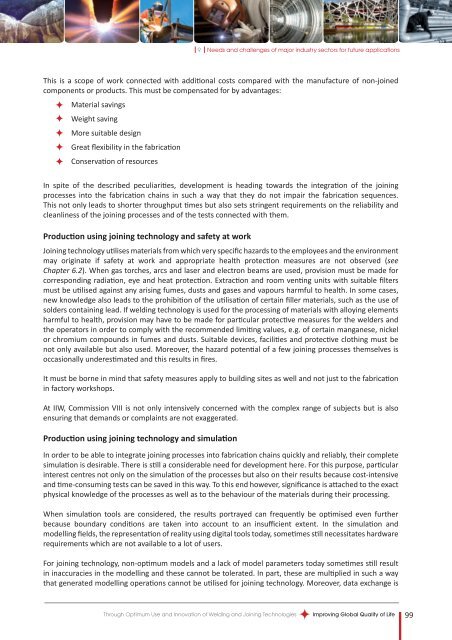Improving Global Quality of Life
Improving Global Quality of Life
Improving Global Quality of Life
You also want an ePaper? Increase the reach of your titles
YUMPU automatically turns print PDFs into web optimized ePapers that Google loves.
9 Needs and challenges <strong>of</strong> major industry sectors for future applications<br />
This is a scope <strong>of</strong> work connected with additional costs compared with the manufacture <strong>of</strong> non-joined<br />
components or products. This must be compensated for by advantages:<br />
Material savings<br />
Weight saving<br />
More suitable design<br />
Great flexibility in the fabrication<br />
Conservation <strong>of</strong> resources<br />
In spite <strong>of</strong> the described peculiarities, development is heading towards the integration <strong>of</strong> the joining<br />
processes into the fabrication chains in such a way that they do not impair the fabrication sequences.<br />
This not only leads to shorter throughput times but also sets stringent requirements on the reliability and<br />
cleanliness <strong>of</strong> the joining processes and <strong>of</strong> the tests connected with them.<br />
Production using joining technology and safety at work<br />
Joining technology utilises materials from which very specific hazards to the employees and the environment<br />
may originate if safety at work and appropriate health protection measures are not observed (see<br />
Chapter 6.2). When gas torches, arcs and laser and electron beams are used, provision must be made for<br />
corresponding radiation, eye and heat protection. Extraction and room venting units with suitable filters<br />
must be utilised against any arising fumes, dusts and gases and vapours harmful to health. In some cases,<br />
new knowledge also leads to the prohibition <strong>of</strong> the utilisation <strong>of</strong> certain filler materials, such as the use <strong>of</strong><br />
solders containing lead. If welding technology is used for the processing <strong>of</strong> materials with alloying elements<br />
harmful to health, provision may have to be made for particular protective measures for the welders and<br />
the operators in order to comply with the recommended limiting values, e.g. <strong>of</strong> certain manganese, nickel<br />
or chromium compounds in fumes and dusts. Suitable devices, facilities and protective clothing must be<br />
not only available but also used. Moreover, the hazard potential <strong>of</strong> a few joining processes themselves is<br />
occasionally underestimated and this results in fires.<br />
It must be borne in mind that safety measures apply to building sites as well and not just to the fabrication<br />
in factory workshops.<br />
At IIW, Commission VIII is not only intensively concerned with the complex range <strong>of</strong> subjects but is also<br />
ensuring that demands or complaints are not exaggerated.<br />
Production using joining technology and simulation<br />
In order to be able to integrate joining processes into fabrication chains quickly and reliably, their complete<br />
simulation is desirable. There is still a considerable need for development here. For this purpose, particular<br />
interest centres not only on the simulation <strong>of</strong> the processes but also on their results because cost-intensive<br />
and time-consuming tests can be saved in this way. To this end however, significance is attached to the exact<br />
physical knowledge <strong>of</strong> the processes as well as to the behaviour <strong>of</strong> the materials during their processing.<br />
When simulation tools are considered, the results portrayed can frequently be optimised even further<br />
because boundary conditions are taken into account to an insufficient extent. In the simulation and<br />
modelling fields, the representation <strong>of</strong> reality using digital tools today, sometimes still necessitates hardware<br />
requirements which are not available to a lot <strong>of</strong> users.<br />
For joining technology, non-optimum models and a lack <strong>of</strong> model parameters today sometimes still result<br />
in inaccuracies in the modelling and these cannot be tolerated. In part, these are multiplied in such a way<br />
that generated modelling operations cannot be utilised for joining technology. Moreover, data exchange is<br />
Through Optimum Use and Innovation <strong>of</strong> Welding and Joining Technologies<br />
<strong>Improving</strong> <strong>Global</strong> <strong>Quality</strong> <strong>of</strong> <strong>Life</strong><br />
99
















